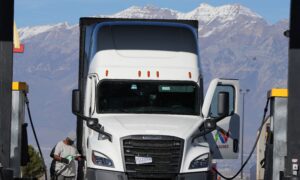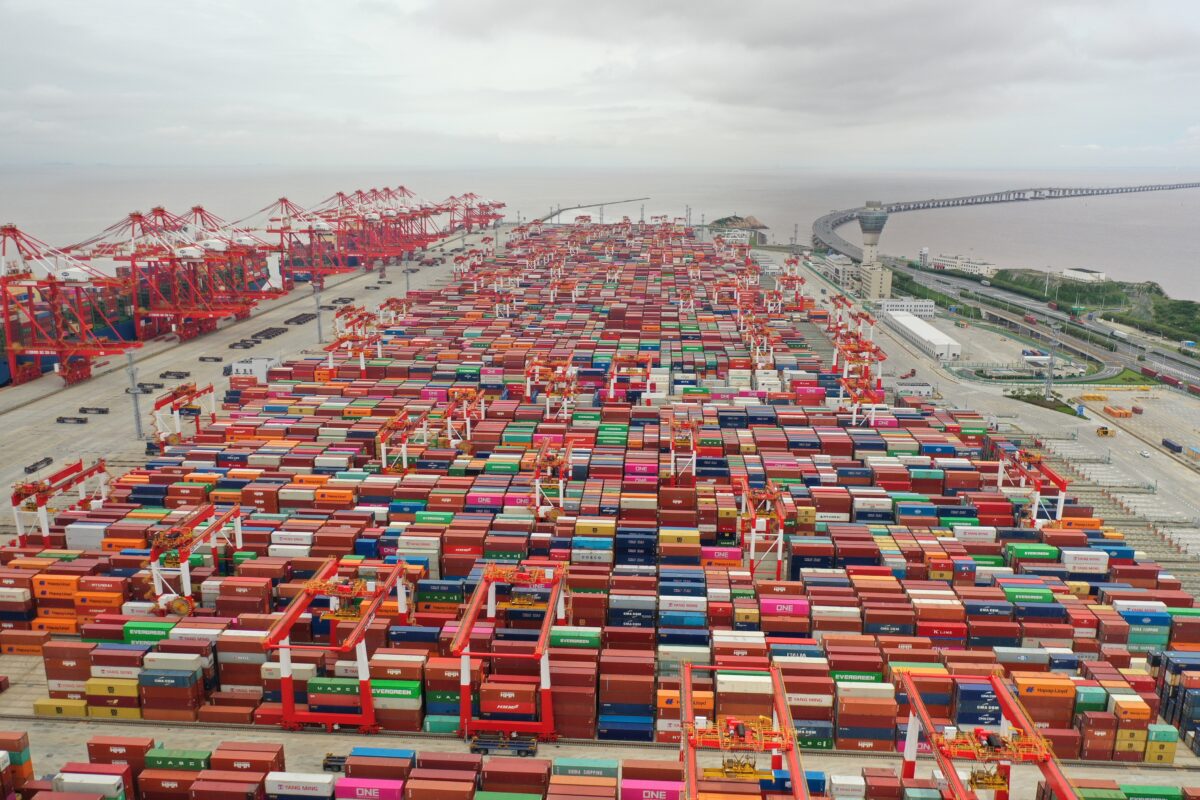Biden’s Economy Is Killing the Trucking Industry
CommentaryDuring the pandemic, freight prices skyrocketed, as did consumer demand, attracting thousands of new companies into the trucking industry. Now, a general economic downturn is dampening consumer demand while the cost of operations is higher. This is forcing carriers out of business. Experts believe we are heading into a trucking market crash caused by overcapacity, inflation, higher gas prices, higher cost for used trucks, and lower consumer demand. In 2021, a near-record number of new trucking companies of 109,340 opened for business. That was 50,202 more new trucking companies than in 2020. The demand for trucking companies is closely linked to the volume of containers arriving at U.S. ports. Using data from the Port of Los Angeles as an example, when COVID-19 lockdowns started in February 2020, container volume had declined 22.87 percent compared to 2019, and in March, it was down 30.94. “The truckers were doing very little at that time,” explained Erik Larson from Sage Live, a freight broker and logistics expert with over 20 years in the industry. Many drivers and carriers were out of business or simply could not afford to drive because the price of shipping was below the cost of operating the trucks. There was less work to go around, and those who were working were earning less because freight prices were dropping based on demand. “But then, when China opened up and started shipping again, the volumes of the container ships shot up,” said Larson. In February 2021, container volume was up 46 percent, and by March, it was up 113 percent compared to the previous year. This is what industry experts refer to as the bullwhip effect. This is when the volume is in a steep decline and drives down shipping prices amid excess capacity. Then, when the snags in the supply chain are smoothed out, there is a flood of new shipping, and the bullwhip hits a peak. Part of the reason for the huge increase in containers was that China was catching up on past orders, which had been held in factories and ports in the country during the lockdown. The other reason was the changes in spending habits by American consumers. Having so many people working from home increased the demand for products such as computer screens, headsets, and home exercise equipment. Larson also speculates that many Americans used their stimulus checks for compensatory spending because they were stuck in the house. All of this increased demand drove the price of shipping to new heights. Aerial view of shipping containers stacked at Yangshan Deepwater Port in Shanghai, China, on May 19, 2021. (Shen Chunchen/VCG via Getty Images) In early 2021, demand outstripped capacity, and there was a shortage of drivers, which drove up wages. And many people who had never been in the industry before saw an opportunity to earn a lot of money. According to Larson, “people used free government loans to get their commercial driver’s license, or if they already had the license, they used a loan to buy a truck. And they were earning 3-4 times the normal rate freight.” Government programs and funding encouraged many new entrants into the industry or encouraged company drivers to purchase a truck and go into business for themselves. For a time, all of these new trucking companies were able to earn a great deal of money. However, things are starting to change in 2022. A terrible economy, high inflation, and low consumer confidence have prevented people from spending. Meanwhile, increasing interest rates and a general slowdown are suppressing construction projects. Industrial activity has resulted in lower consumer demand and lower freight volumes. The August container volume at the Port of Los Angeles was down 15.62 percent compared to 2021, and September was down 21.46 percent. October, November, and December normally show high volumes of freight due to the Christmas shopping season, but Larson expects the numbers for the year’s final quarter to be even worse. Lower freight volumes in the coming month can be predicted based on the tender rejection rate, which is the number of loads per 100 that companies have to reject because they are already at max capacity. In June 2020, the tender rejection rate peaked at about 28 per 100, meaning that demand for trucking exceeded supply by about 28 percent. The rate should be increasing this time of year. Instead, it is in decline. In October, the rate was just over 4 per hundred, and the trend is downward. The Downfall of Trucking in Biden’s Economy A trucking company is like any other business. It must earn an acceptable profit above its costs to remain in business. In hard times, it may make no profit, but it will continue to operate as long as income is at or above cost. When calculating the cost of operations in 2019, a company might have purchased a used truck for $50,000. Considering the amortized value of the truck plus the interest on loans (excluding fuel), it worked out to $0.15 per mile to operate a tru

Commentary
During the pandemic, freight prices skyrocketed, as did consumer demand, attracting thousands of new companies into the trucking industry. Now, a general economic downturn is dampening consumer demand while the cost of operations is higher. This is forcing carriers out of business.
Experts believe we are heading into a trucking market crash caused by overcapacity, inflation, higher gas prices, higher cost for used trucks, and lower consumer demand. In 2021, a near-record number of new trucking companies of 109,340 opened for business. That was 50,202 more new trucking companies than in 2020.
The demand for trucking companies is closely linked to the volume of containers arriving at U.S. ports. Using data from the Port of Los Angeles as an example, when COVID-19 lockdowns started in February 2020, container volume had declined 22.87 percent compared to 2019, and in March, it was down 30.94. “The truckers were doing very little at that time,” explained Erik Larson from Sage Live, a freight broker and logistics expert with over 20 years in the industry. Many drivers and carriers were out of business or simply could not afford to drive because the price of shipping was below the cost of operating the trucks.
There was less work to go around, and those who were working were earning less because freight prices were dropping based on demand. “But then, when China opened up and started shipping again, the volumes of the container ships shot up,” said Larson.
In February 2021, container volume was up 46 percent, and by March, it was up 113 percent compared to the previous year. This is what industry experts refer to as the bullwhip effect. This is when the volume is in a steep decline and drives down shipping prices amid excess capacity. Then, when the snags in the supply chain are smoothed out, there is a flood of new shipping, and the bullwhip hits a peak.
Part of the reason for the huge increase in containers was that China was catching up on past orders, which had been held in factories and ports in the country during the lockdown. The other reason was the changes in spending habits by American consumers. Having so many people working from home increased the demand for products such as computer screens, headsets, and home exercise equipment. Larson also speculates that many Americans used their stimulus checks for compensatory spending because they were stuck in the house. All of this increased demand drove the price of shipping to new heights.

In early 2021, demand outstripped capacity, and there was a shortage of drivers, which drove up wages. And many people who had never been in the industry before saw an opportunity to earn a lot of money. According to Larson, “people used free government loans to get their commercial driver’s license, or if they already had the license, they used a loan to buy a truck. And they were earning 3-4 times the normal rate freight.” Government programs and funding encouraged many new entrants into the industry or encouraged company drivers to purchase a truck and go into business for themselves. For a time, all of these new trucking companies were able to earn a great deal of money.
However, things are starting to change in 2022. A terrible economy, high inflation, and low consumer confidence have prevented people from spending. Meanwhile, increasing interest rates and a general slowdown are suppressing construction projects. Industrial activity has resulted in lower consumer demand and lower freight volumes.
The August container volume at the Port of Los Angeles was down 15.62 percent compared to 2021, and September was down 21.46 percent. October, November, and December normally show high volumes of freight due to the Christmas shopping season, but Larson expects the numbers for the year’s final quarter to be even worse.
Lower freight volumes in the coming month can be predicted based on the tender rejection rate, which is the number of loads per 100 that companies have to reject because they are already at max capacity. In June 2020, the tender rejection rate peaked at about 28 per 100, meaning that demand for trucking exceeded supply by about 28 percent. The rate should be increasing this time of year. Instead, it is in decline. In October, the rate was just over 4 per hundred, and the trend is downward.
The Downfall of Trucking in Biden’s Economy
A trucking company is like any other business. It must earn an acceptable profit above its costs to remain in business. In hard times, it may make no profit, but it will continue to operate as long as income is at or above cost. When calculating the cost of operations in 2019, a company might have purchased a used truck for $50,000. Considering the amortized value of the truck plus the interest on loans (excluding fuel), it worked out to $0.15 per mile to operate a truck. In Biden’s economy, the cost per mile is $0.23.
Of course, the price of gas has doubled, but so has the price of all other variable costs of operating a truck. A driver in 2019 costs $0.47 per mile, while in 2022, the cost is $0.62 per mile—an increase of $0.15 per mile. Insurance is up by $0.02/mile, maintenance is up $0.06/mile, and equipment increased by $0.08/mile. In total, the variable cost went up by $0.31/mile plus the cost of gas.
The lower volume of shipping is driving down the rates, and the higher costs are making it harder for carriers to make a profit. Industry experts expect a sharp rise in bankruptcies over the coming months.
Views expressed in this article are the opinions of the author and do not necessarily reflect the views of The Epoch Times.












